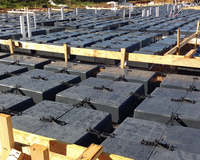Soil conditioning and site remediation are processes that improve the conditions of soil for construction purposes.
Depending on the results of your soil report, these improvements can be a lengthy and expensive process. Here’s what you need to know about soil conditioning and site remediation and why they are important.
Read until the end to discover how you could avoid this costly process altogether with the Wafflemat Foundation System.
What does “Soil conditioning” mean in construction?
The purpose of soil conditioning is to change the physical properties of soil. Clay, for example, expands when moisture content increases and then contracts when it dries, causing a foundation to undergo stresses that could cause a failure. Expansive soils are present in many areas of the United States and around the world. Expansive soils are a leading cause of damage to homes in areas where expansive soils are present.
The results of your soil report will inform you on what steps you need to take to ensure the long-term integrity of your building. Neglecting to build with your soil in mind could lead to a foundation failure and catastrophic damage to your building.
 Reasons for soil conditioning:
Reasons for soil conditioning:
- Provide stability for your foundation
- Improve soil properties when exposed to water
- Avoid the need for future repairs
- Increase weight-bearing capacity
- Reduce plasticity and resistance to movement
- Prepare site after previous construction
If you choose to condition your soil to improve its physical properties, you’ll have many methods to choose from. Each has its pros and cons regarding expense, best practices, effectiveness, and time.
One popular method for adding stability to the soil is to remove several feet of native soil, then replace it with what is known as select fill. The process consists of back-filling with a mixture of crushed limestone or sand. Another form of soil conditioning involves injecting the site’s soil with water or a chemical solution that can help stabilize expansive clays. Depending on the composition of your soil and the specifications of your construction project, one or more of these options may be recommended by your GeoTechnical Engineer.
Importance of soil remediation in construction
Soil remediation in construction is the process of removing pollutants or contaminants from the soil. Contaminants and pollutants commonly found in soil can have significant health consequences when they aren’t remediated. They can damage the surrounding environment and our health through constant exposure to contaminated soils.
Radon is a good example that demonstrates the importance of site remediation. According to the CDC, radon contamination is the second leading cause of lung cancer after smoking, and unfortunately, people are primarily exposed to radon in their homes.
Other types of soil contaminants include pesticides, petroleum products, asbestos, lead, creosote, and heavy metals.
How do you choose the right site remediation process? This will depend on the contaminant, what is causing it, and how close your site is to environmental pollutants. Common site remediation strategies can include electrical resistance heating, soil vapor extraction, chemical oxidation, and excavation.
The need for soil remediation can often come as a surprise for many builders and pose unique challenges for engineers. Site remediation strategies will raise costs, delay the start of your project, and require a unique approach to building your foundation.

Challenges with soil remediation and conditioning
A site’s soil condition is one of the biggest unknowns for people buying land or older homes. The need to condition the soil can come as an expensive surprise to builders ready to start construction on a project.
Soil remediation and conditioning can also be expensive, time-consuming, and are dependent on your soil test results and local requirements. It can be challenging for builders and engineers to work with bad soil conditions and your intended design.
But you can't underscore the importance of addressing the issues highlighted in your soil report. Finding a solution to bad site soil will prevent many future problems with your building and issues with liability.
Is there a better way?
Want to avoid or reduce the need for soil conditioning all together? Wafflemat is an engineered foundation system specifically designed to accommodate expansive soil, meaning that in many cases, no soil conditioning is necessary!
The above-ground design allows the foundation to easily overcome unstable soils, especially expansive clay. Whether you’re working with sand, gravel, or contaminated soil, you can satisfy local requirements and save valuable time and resources.
Contact us to speak with an expert and see if the Wafflemat Foundation system is the solution for your site.






